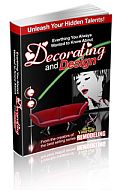Welcome to Interior Painting Guide
FAUX FINISHES Article

FAUX FINISHES
from:Faux finishes can be divided into either positive or negative techniques. Covering the
wall with a coat of glaze and then using a tool to remove it is a negative technique
because you are taking glaze away. Loading a tool with glaze and applying it to the
wall is a positive technique. Whichever technique you use practice is essential to creating
an even design. Practice your faux finish in a laundry room or guest room where any
mistakes will not be as noticeable.
Fifty percent of a faux finish effect is derived from the base coat or foundation.
Preparation is essential to a good final finish. Thirty percent of the finished effect is from
the glazing medium and its interplay with the base coat. Ten percent is created by the
application tool and the impression it makes and the last ten percent of your faux finish
is created by you and your application style.
Regardless of the effect you want to create in your faux finish the first step is to prepare
your walls by washing them. The next step is to paint your base coat. If you are a novice
paint the dark color as your base because it is easier to lighten a color than darken it. Use
a satin or eggshell interior latex paint for your base coat. Flat paint has a high porosity
and no sheen value. Satin latex has a slight sheen that is ideal for decorative effects.
Allow the base coat to dry completely but don’t wait more than a week to apply the
top coat. Waiting longer can jeopardize the paint job because of everyday contaminants
such as hair spray, cooking oil and general dust buildup. These contaminants put a film
on the clean surface and prevents proper adhesion of the glaze for your faux finish.
Use a plastic hair comb or window squeegee to for a dragging technique that leaves
grooves in the faux finish by removing glaze. The wider the notches cut in the rubber
squeegee the wider the stripes.
Use a feather duster or barbecue brush to lift the glaze from the wall. When you dance the
duster over the wall it allows the base coat to dance through. This method called stippling
creates dimension.
In the faux effect called rolling try using a roller with a terry cloth rag or bubble wrap
attached with rubber bands. Work in a random pattern to pick up the glaze.
When searching for a tool to create a faux effect look for items made of plastic
that have textural elements like bristles and fabric or a raised surface. Try to find items
with a handle for ease of use. If you are going to be working on a large area use a larger
tool to speed completion time. Buy two of the same item so one can be drying while
you are using one. Sometimes the wackiest items make the best effects. Consider using
a toilet brush, fly swatter, or a duster car mop. Look in the automotive and household
cleaning sections of your store for inspiration. You’ll never see these items the same
way again.



